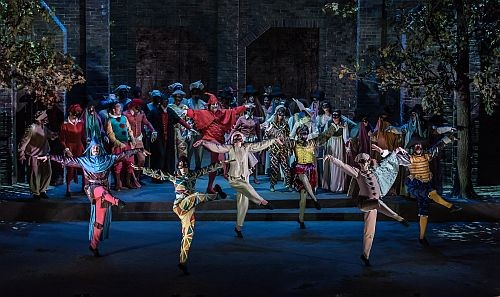 Ireland Hérold, Le Pré aux Clercs: Wexford Festival Opera Orchestra and Chorus, Jean-Luc Tingaud (conductor), National Opera House, Wexford, 29.10.2015 (JMI)
Ireland Hérold, Le Pré aux Clercs: Wexford Festival Opera Orchestra and Chorus, Jean-Luc Tingaud (conductor), National Opera House, Wexford, 29.10.2015 (JMI)

Hérold, Le Pré aux Clercs
New production with Paris Opéra Comique
Direction: Éric Ruf (original) revived by Laurent Delvert
Sets: Éric Ruf
Costumes: Renato Bianchi
Lighting: Ian Sommerville
Cast:
Marguerite de Valois: Marie Lenormand
Isabelle de Montal: Marie-Ève Munger
Baron de Mergy: Nico Darmanin
Nicette: Magali Simard-Galdes
Girot: Tomislav Lavoie
Cantarelli: Éric Huchet
Count of Comminges: Dominique Côté
This French comic opera by Ferdinand Hérold was the final production of the 2015 Wexford Festival. It seemed a slightly odd choice to me ̶ the opera is indeed a rarity, but it had been performed last spring at Salle Favart in Paris.
Hérold was undoubtedly the most popular French opera composer in the first half of the 19th century. Le Pré aux Clercs, together with his Zampa, were part of a very select group of most-performed operas in Paris. Over the years, there were more than 1600 performances, almost all of them taking place before the First World War. Afterwards, this opera genre, like zarzuela in Spain, lost its popularity, and revivals were almost nonexistent.
A remarkable musician, Hérold possessed a great ability to produce light and lively music that kept French audiences entertained. It’s similar to what happened years later with Jacques Offenbach. Le Pré aux Clercs is the last opera Hérold composed, and he died just ten days after its premiere. It’s a true comedy, very reminiscent of operetta, with long dialogues that nowadays seem dated. The world premiere took place in 1832, when Rossini was adored, and the work is reminiscent of the composer from Pesaro, with an overture that could have been written by Rossini himself.
The Opéra Comique in Paris decided to dust it off with a new production by Éric Ruf, in co-production with the Wexford Festival. The staging is traditional, tastefully done and respectful of the time of the plot: the 16th century, soon after the infamous St. Bartholomew’s Day massacre. The simple sets allow for quick scene changes, and the costumes are attractive. The stage direction works nicely, particularly in the crowd scenes, and the choreography is good.
Jean-Luc Tingaud offered an effective and lively reading. I don’t think you can expect much more from a conductor with an opera like this. There was a solid performance by the orchestra, and the chorus was excellent.
The cast largely repeated the line-up from the recent Paris premiere, but there were some changes that I think were not for the better.
Marguerite de Valois, Queen Margot, was interpreted by French mezzo-soprano Marie Lenormand, who did well vocally and showed a full mastery of the character, especially in the dialogues. Her lady in waiting, Isabelle de Montal, was Canadian soprano Marie-Ève Munger, who sang the most brilliant aria in the whole opera. She has an attractive, well-handled voice and sings with gusto, but her high notes tend to get too narrow and metallic.
Isabelle’s beloved, Baron de Mergy, was sung by tenor Nico Darmanin, who is too stiff on stage. At the Paris premiere, the character was played by Michael Spyres, and we lost with this change.
The other pair of lovers consists of Nicette, the goddaughter of Queen Marguerite, and the innkeeper Girot. Nicette was performed by soprano Magali Simard-Galdes, a very light soprano, whose voice is too small for the part. In Paris the role was played by soprano Jael Azzaretti, and I missed her. Girot was Tomislav Lavoie, who was adequate.
The comic duo was made up of Éric Huchet as Cantarelli and Dominique Côté as the Count of Comminges. The former, a very amusing performer, is one of those who fill the stage when present.
Once again the house was sold out, and the audience seemed very happy with the performance.
Jose M. Irurzun
